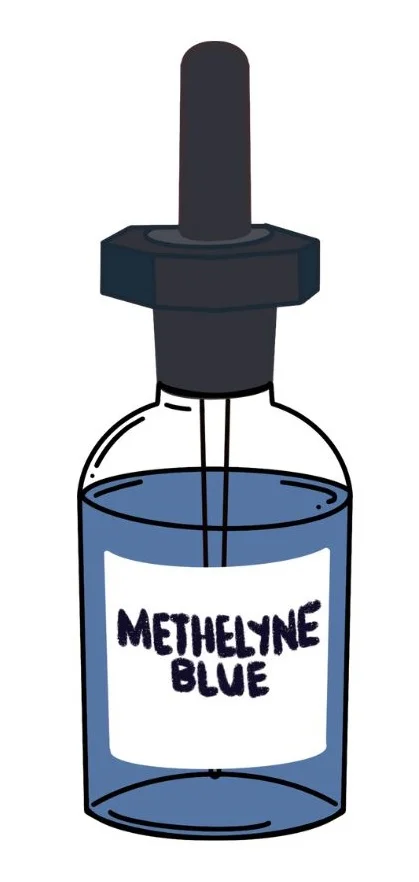Methylenum Coeruleum, commonly known as Methylene Blue, is an aniline dye with notable therapeutic applications in medicine.
It is recognized for its efficacy in treating conditions such as neuralgia, neurasthenia, malaria, typhoid fever, and infections characterized by pus formation.
Additionally, it is indicated for various neurological disorders, urinary tract irritations, and surgical complications.

SOURCE INFORMATION
Scientific Classification
- Chemical Classification: Aniline Dye
- Chemical Formula: C₁₆H₁₈ClN₃S
- Synonyms: Methylene Blue, Methylthioninium Chloride
Historical Background
- Methylene Blue was first synthesized in 1876 by Heinrich Caro and quickly gained recognition for its versatile properties.
- Originally used as a dye in textiles, its medicinal applications were later discovered due to its ability to interact with biological systems, particularly in treating various infections and neurological conditions.
DRUG PATHOGENESIS
- Therapeutic Effects: Methylene Blue acts as a redox agent and has bacteriostatic and antifungal properties.
- It also serves as a metabolic indicator in certain diagnostic procedures.
- Medical Uses: It is employed in treating conditions such as malaria, where it targets the malaria parasite, and in urinary tract infections to alleviate bladder irritation.
KEY CHARACTERISTICS
- Neurological Disorders: Effective in neuralgia, neurasthenia, tremors, chorea, epilepsy, and late-stage apoplexy.
- Infections: Used for pus infections, including scarlatinal nephritis and acute parenchymatous nephritis.
- Urinary Tract: Indicated for cystitis, gonorrhoeal rheumatism, and conditions with green-coloured urine.
DETAILED ORGAN SYMPTOMS
Neuralgia and Neurasthenia
- Neuralgia Relief: Effective in alleviating severe nerve pain, such as that caused by neuralgia, by modulating pain perception pathways.
- Nervous Exhaustion: Provides relief from symptoms of neurasthenia, including fatigue, weakness, and generalized pain, helping to restore energy levels and overall well-being.
Malaria and Typhoid
- Fever Reduction: Diminishes fever associated with malaria and typhoid, aiding in the management of these infectious diseases.
- Delirium Management: Helps reduce delirium, which can occur during high fevers in these infections, contributing to patient comfort and recovery.
- Tympanites Relief: Alleviates tympanites, the abdominal distension caused by gas accumulation, improving patient symptoms and comfort during illness.
Urinary System
- Cystitis Treatment: Effective in treating cystitis, inflammation of the bladder, by exerting anti-inflammatory and antibacterial effects.
- Nephritis Management: Manages nephritis, kidney inflammation, often characterized by green-colored urine due to the presence of Methylene Blue, aiding in symptom relief and therapeutic monitoring.
Neurological Conditions
- Epilepsy Control: Helps in controlling seizures in epilepsy by stabilizing nerve cell membranes and modulating neurotransmitter function.
- Tremor and Chorea: Aids in reducing tremors and chorea (involuntary movements) by regulating nerve impulses and improving motor control.
Surgical Complications
- Infection Management: Addresses infections with significant pus discharge, such as those in surgical kidney cases, by exerting bacteriostatic effects and promoting healing.
- Post-surgical Care: Used in post-surgical settings to prevent secondary infections and support the body’s natural defenses against microbial invaders.
MODALITIES
- Antidote: Nutmeg is used to counteract bladder irritation caused by Methylene Blue.
- Local Applications: A 2% solution is beneficial for chronic otitis and foul-smelling ear discharge.
- A 1% aqueous solution is applied to treat corneal ulcers and abscesses.
WHAT ARE MODALITIES IN HOMOEOPATHY?
RELATIONSHIP WITH OTHER DRUGS
- Comparative Remedies: Comparable to other remedies used in treating neurological disorders, infections, and urinary tract irritations.
DOSE
- Oral Dose: Typically administered in 3x attenuation.
- Topical Use: Applied locally as a 2% solution for ear conditions and a 1% solution for corneal ulcers.
Frequently Asked Questions (FAQs)
What conditions is Methylene Blue used for?
- It is used for neuralgia, neurasthenia, malaria, typhoid fever, and infections with pus formation.
How does Methylene Blue affect neurological disorders?
- It helps alleviate symptoms of tremors, epilepsy, and nerve pain.
What is the significance of green-colored urine in relation to Methylene Blue?
- It indicates its presence in the body and is a characteristic sign of its metabolic activity.
Meaning of Difficult Words
- Neurasthenia: A condition characterized by fatigue, weakness, and generalized pain.
- Parenchymatous Nephritis: Inflammation affecting the functional units of the kidney.
- Gonorrhoeal Rheumatism: Joint inflammation due to gonorrhoea infection.
This comprehensive overview provides insights into the medicinal properties, historical background, therapeutic uses, and practical applications of Methylene Blue, making it valuable for both medical professionals and individuals interested in its homeopathic applications.
